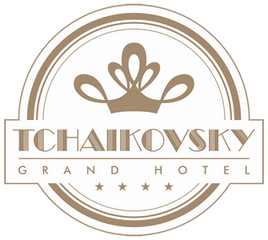Official site of the grand hotel "Tchaikovsky"

55 Tchaikovsky St.,
Saint-Petersburg, Russia
(Reception)
+7 (812) 600-24-11
(Sales & Reservations Department)
Official site of the grand hotel "Tchaikovsky"

55 Tchaikovsky St.,
Saint-Petersburg, Russia
(Reception)
+7 (812) 600-24-11
(Sales & Reservations Department)
ABOUT HOTEL
The Grand Hotel Tchaikovsky, being located in a building that is an object of cultural heritage of regional significance, conveys the atmosphere of true St. Petersburg and combines it with modern design and technology.
The design of 69 rooms in 6 categories, which are able to accommodate up to 170 people, is made in a classic modern style, the interior pleases the eye and creates an atmosphere of comfort and convenience. There are available one-room and two-room (family and suite), for romance lovers we offer accommodation in the attic rooms sky. Suites are a perfect choice for the most demanding guests; they have not only two rooms, but also a separate bathroom for each of them. Stylish interior, thought-out to the details, spacious exquisite living room, luxurious bathroom with bath – here is everything to make your stay unforgettable.
There is also a restaurant in the hotel where the breakfasts are served. Lunch and dinner are served for the groups of 8 or more people. All the necessary equipment for conferences and banquets is presented in the restaurant.
PHOTO
VIDEO
HISTORY
In 1733 Anna Ioannovna issued a decree on the resettlement of artillery officers here. The lines become artillery, the 3rd line from Neva becomes the 2nd Artillery. After the construction of the church of Sergius of Radonezh it became known as Sergievskaya, this name became official in 1762.Until 1770 Sergievskaya Street did not have a connection with the Fontanka bank, it reached only to the Kosoy Channel (the modern street of the Gunsmith Fedorov). Between the Kosoy Channel and the Fontanka the ponds were set up to divide fish for the royal table. Here was the reserve yard where the supplies of the royal court were kept. In 1770 the canal and the ponds were filled up, the street was extended to Fontanka.
Until the middle of the XIX century most of the houses here were built of wood, some were with stone bottom and wooden top. In 1848 in the central districts of St. Petersburg it was forbidden to build wooden front houses, since then - stone houses have been built on Sergievskaya Street.On October 6, 1923 the Petrograd Provincial Executive Committee issued a resolution to name a group of city streets in honor of revolutionary figures, as well as artists. The name also indicated the sphere of activity: the Writer's Channel Griboyedov, Decembrist Petel Street, Zodchego Rossi Street. Sergievskaya street received the name of the composer Tchaikovsky.Peter Ilyich Tchaikovsky studied at the School of jurisprudence from 1850 to 1859, it was located on the corner of Sergievskaya Street and the Fontanka embankment. Part of the composer's life took place in the house №12 on this street. In 1852-1853 his parents lived in the house №41.
ИСТОРИЯ
There is a version about the name of Sergievskaya street named after Nikolai Tchaikovsky, one of the founders of the youth revolutionary sections. In the Foundry part of the city many streets are named after revolutionary figures (Pestel, Ryleev). These names were given to streets in 1917, Sergievskaya could be renamed. However, until 1923, the street were always referred to as Sergievskaya.
In its front building there were huge multi-room apartments - only two on each floor: they had 15-20 rooms. On the 2nd and 3rd floors, in addition to the "masterly" apartments, another 4 apartments were arranged, from 1 to 3 rooms. Their windows faced to the courtyards. Later in different years the house was owned by the count dynasties of Muravyovs and Sheremetyevs, and then up to the revolution it belonged to industrialist, chairman of the Russian-Asian bank Alexei Putilov.
In Soviet times communal apartments appeared here. The building is included in the list of monuments of regional significance: in 2001 the house was included by KGIOP in the "List of newly discovered objects of historical, scientific, artistic or other cultural value"